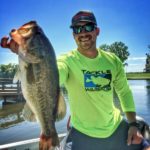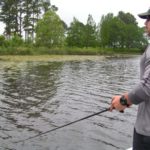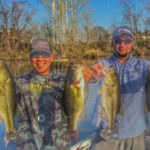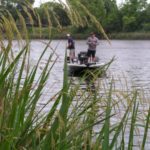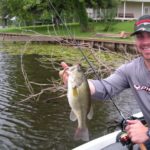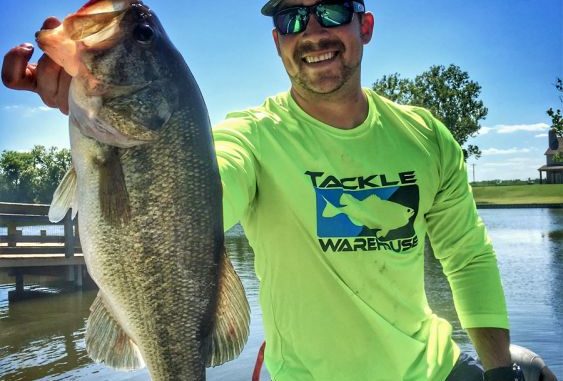
There’s a summer bass party in the City of Lights.
Logan Mount moves his boat down the thick patches of Zizania grass lining the Cane River bank in Natchitoches as if he’s piloting a John Deere combine harvesting summer grain. But he isn’t harvesting wild rice. He’s taking advantage of the summer to reap a crop of largemouth bass.
The young Leesville angler loves bass fishing. And even though he fishes competitively on many big reservoirs and rivers, there’s nothing like fishing the 33-mile long river than runs right through the heart of the City of Lights.
Natchitoches is famous for its historic bed and breakfast business, meat pies, century old brick streets and the state’s most popular Christmas light and fireworks show. But none of that matters to Mount. He’s after largemouth bass.
“Cane River is loaded with bass,” he says. “It isn’t known for a lot of trophy bass, but the population of healthy two and three pound bass is amazing. The best thing about Cane River for fishermen is that you don’t have to spend hours searching for bass spots on electronics or looking for hidden structure. You just put down the trolling motor and power fish down the bank until you find some fish. Then you keep targeting the areas where you’ve found fish.”
Cane River defies the old bass fishing rule that 90% of the fishermen are fishing where only 10% of the bass are, which is normally the case when fishermen target bank structure alone. You can reverse those numbers for all practical purposes on this old oxbow, which was cut off from the rest of the Red River when it changed course back in the 1800s.
“During the summertime, the lilly pads have come up, grown off the bank and made some great cover for bass fishing,” he says. “On the upper ends of the river, the milfoil patches have topped out and offer great places for bass to hide. There are even laydowns that reach out into deeper water and while they don’t always hold fish, there are times in the summer when you can back off and catch good ones, there, too.”
But those are just “other places” to look for fish for the most part. It’s the miles and miles of Zizania, a wild rice type grass that most fishermen just call “reeds,” growing along the banks of the river that get most of Mount’s attention as well as other anglers. And in this case, even though the taxonomy might not be right, maybe they should be called “canes.”
“In some places, the reeds are in single or double bunches on the bank,” he says. “But in other areas, they can grow out from the bank 10 feet or so. When they do that, they are great hiding places for largemouth bass.”
There are two reasons Mount says the bass get back in the reed patches. First, it’s cooler than on the edges or in the open water. Second, it’ where the bream are. Bream are the meat pies of the Cane River. Bass love to eat them and fishermen take advantage of that. Where you find bream, you can usually find hungry bass.
Here’s what Mount and his fishing partner Casey Stephens do to entice these cane-bound bass.
“We never go to Cane River this time of year without being rigged up to punch baits back up in the thick reed,” Mount says. “We fish ¾-ounce punch weights with craw tubes or Brush Hawg type lures. We actually punch the baits through the cover and force the lures back in the openings among the reeds and that’s where we find the bass. Sometimes they are only in one or two feet of water, but the reeds are so thick the water is cool, has plenty of oxygen and definitely provides cover and baitfish.”
When he is flipping or punching he likes dark colors on the Cane River for the most part. Green pumpkin, black and blue and black and red are his favorites. He also likes to fish color or dark weights instead of shiny ones. When that isn’t producing, Mount goes back to the lily pads and begins tossing plastic frogs and plopping them back through the pads. It’s important to pay attention when fishing the frogs for several reasons. First, you need to always be looking for fish moving pads, or chasing baitfish and you need to target those areas. You also need to keep up with where you see fish or get bites.
“Sometimes the fish will hang right on the edge of the pads, but more than likely they are up in the middle of them, or at times, way back up close to the bank. When you get bit in one of those spots, that’s where you need to concentrate your casts.”
There are some differences in terrain and fishing habitat in the river. On the north end, there are big areas with milfoil as well as pads and reeds. The water also tends to be more stained on the north end. In the middle section of the river, there are more boathouses, seawalls and other man-made structure. These will produce fish, but usually the best ones have grass or other vegetation around them. There are reeds all along the river, but the areas further south have more. On the far south end of the lake before you get to the dam, there are some pockets and runouts that offer good fishing. Most of these have lots of laydowns as well.
And Mount doesn’t pass those up either.
“Sometimes the bass get up shallow and suspend in the tops and you can catch them on frogs, wacky worms or even spinnerbaits,” he says. “And if they aren’t shallow, you can back off and fish Texas-rigged plastic worms through the tops all the way back out to deeper water. Sometimes the fish will be on the edge of the tops out on the drops into deeper water. It depends on where the baitfish are.”
The Cane gets busy in the summer, especially on the weekends. Fish early and late to avoid lots of party barge and skiing type activity. Use caution when boating and make sure you know the regulations on the river. If the weather has been erratic, also check to make sure the river is open. It is closed to boating on occasion because of high or low water conditions.
You can find out more information about the river and its facilities, such as public boat ramps, at caneriverwaterway.com or from the Natchitoches Parish Chamber of Commerce.
